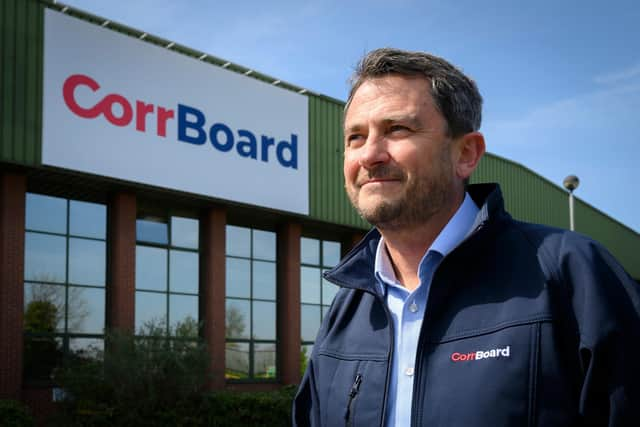How cardboard manufacturer Corrboard uses food waste to power its factory
The Scunthorpe-based company, which produces sheets of corrugated board to be turned into a variety of cardboard boxes for the food industry, already creates 100 per cent of its electricity from the anaerobic digestion plant on its site. Its aim now is to bring the biogas created by bugs in the plant into the main building too.
Rob Burgin, managing director of Corrboard, which has a £50m turnover and employs 90 staff, said: “We expect that by the end of next year, 100 per cent of the electricity and gas used in our manufacturing process will be completely carbon neutral.”
Advertisement
Hide AdAdvertisement
Hide AdMr Burgin’s five-year plan is to make the whole site carbon-free, eventually replacing its LPG trucks with electric trucks.


He added: “The drive behind it is to get Corrboard to the point where we can remove fossil fuels from our site completely but right now, at a time when energy prices have shot up, it’s ideal because it means we can come off the grid.”
Food waste from the supply chain is the raw material that goes into the anaerobic digestion plant. The plant is capable of processing over 100,000 tonnes of food waste each year into renewable biogas.
The plant takes packaged food waste and separates the packaging from the food. The packaging is shredded to go back into the paper making process while the gas from the food waste is turned into energy.
Advertisement
Hide AdAdvertisement
Hide AdThe other product that comes out of the plant is a digestate that is collected and used as fertiliser on land in Lincolnshire.
Mr Burgin said: "That’s where the truly circular element of this comes in. We have three tanker loads of this digestate going back out to farmers every single day, that’s about 30,000 tonnes a year .”
The anaerobic digestion plant has the capacity to produce about five megawatt hours of energy per year. “That’s what our combined electricity and gas usage is,” he added.
Generating energy from waste is more often seen in paper mills further up the supply chain. “For a sheet feeder to be independent and have its own energy source is pretty unique right across Europe,” Mr Burgin said.
Advertisement
Hide AdAdvertisement
Hide Ad"For a business our size to have invested £7m in an anaerobic digestion plant at a time when energy costs were not peaking was a bold decision. The vision from our shareholders to take a long term view of the payback in terms of the carbon footprint of the site rather than just focus on the cost saving is why we’ve got the plant today.”
The main challenge for the company at the moment is input cost increases. While Corrboard is in a strong position when it comes to its electricity, the price of wheat starch – an important ingredient in the cardboard-making process - has trebled this year due to the war in Ukraine because the country is a major supplier of wheat in Europe.
While the energy price increases don’t directly affect Corrboard’s factory, most of the paper industry relies on fossil fuels, which has pushed paper prices to a record high at a time when demand is low.
Demand for the cardboard packaging industry is 20 per cent down on last year, Mr Burgin said, as consumers change their purchasing habits due to the cost of living crisis.
Advertisement
Hide AdAdvertisement
Hide AdIt follows a booming two years for the packaging industry during the covid-19 pandemic as ecommerce rocketed. Looking ahead, Mr Burgin said: “We’re expecting the market to be fairly turbulent until the summer of next year.”
Video credit: CorrBoard Bioenergy